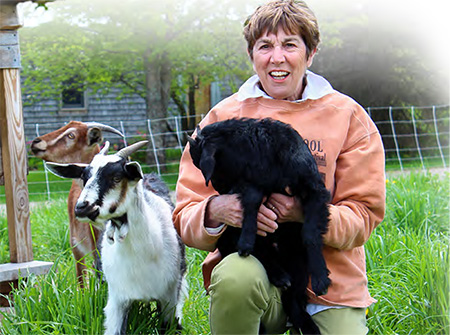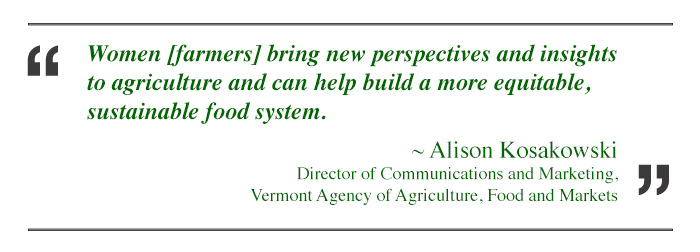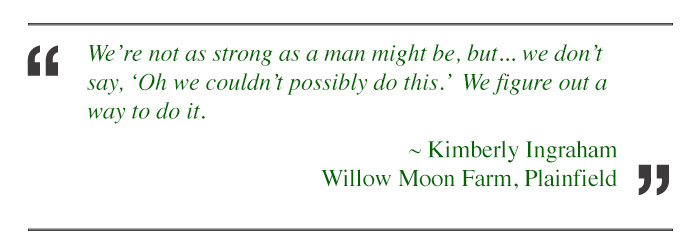| The Changing Image of Vermont’s Farmers | |
by Sarah Galbraith |
|
The role of Vermont women in farming is changing. As recently as a generation ago, women for the most part assisted the farmer, usually a husband or father. But these days, they are increasingly in leadership positions, running their own farms and food businesses. They are growing organic vegetables, producing humanely raised meat, and making their own award-winning cheeses, all while keeping the financial books in order, overseeing staff, marketing their products, setting up shop at weekend farmers’ markets, and fulfilling wholesale orders. Nationally, the number of farms for which women make the day-to-day decisions as the principal operator rose from 5 percent in 1978 (the year the US Department of Agriculture first asked respondents to indicate gender on its Farm Census) to 11 percent in 2012, when the most recent census was completed. FarmHer (www.farmher.com), a photographic project showing women in farming, says on its website, “Women have always been an important but mostly undocumented aspect of agriculture. In recent years, women are rising to the forefront of agriculture in so many ways; as owner/operators, landowners, workers, mentors and so many more.”
Vermont Leads in Female Farmers Vermont is in fact among the national leaders in this trend, placing ninth in the nation for the percentage of women (22 percent) serving as the principal farm operator. Among the 7,300 farms in Vermont that are operated by farmers for whom farming is their primary occupation, 1,642 of those are run by women. Farming and food production are an important part of Vermont’s economy. Although the overall annual growth of Vermont’s economy is just 1 percent, the farming and food portion of the economy grows 3 percent on average, adding over 600 new farm and food businesses and creating more than 8,000 new jobs annually. And in this growing segment, women’s contributions are increasing. Although Vermont’s farm and food economic sector has seen much growth and success, nationally there is still a growing disparity between the number of farmers and mouths to feed. “Less than 2 percent of our country’s population farms for a living,” says Alison Kosakowski, director of communications and marketing at the Vermont Agency of Agriculture, Food and Markets. “We have fewer farmers but more mouths to feed. You can see that math doesn’t add up.” There is a need, then, to engage more people in farming to feed our communities, and the relatively low percentage of women in farming provides an opportunity. Given that fewer women than men are farming, the farm and food sector can expand simply by encouraging more women to farm. “Here in Vermont, we are working hard to support all types of farmers, especially female farmers,” says Kosakowski. “Women bring new perspectives and insights to agriculture and can help build a more equitable, sustainable food system. Diversity, of all kinds, will only serve to enrich the industry.” Women are also growing the next generation of farmers and eaters, points out Destiny Carson with the National Women in Agriculture Association, based in Oklahoma. “Women share their passion with their kids, so when you support women in agriculture, you are supporting the next generation in agriculture,” she says. Of course, farming is farming, and it’s hard work—long hours along with the financial ups and downs of operating your own business. The challenges of farming are not unique to women in farming. “Farming is hard whether you're single, a couple, or a family,” says Nichole Duch of Seedfolks Farm in East Calais (http://seedfolksfarm.com). She totes up an incredibly long list of daily chores on her farm, from picking up supplies, amending soil in her fields, cultivating and prepping the ground, checking on fields, organizing records, and paying bills. “But it’s not because I’m a woman, it’s because I’m a good farmer,” she says. Some challenges are unique to women who are the sole proprietor of their farm, though. For one, there is heavy lifting, like buckets of goats’ milk at Willow Moon Farm in Plainfield, flats of vegetable seedlings at Bella Farm in Monkton, or fencing that needs to be moved regularly at Tannery Farm and Vermont Chevon in Danville. Male farmers also do not have to contend with pregnancy and birth. “Even the most hardcore female farmers have to take time off for the actual birth, never mind the additional time and shifting priorities that accompany having a family,” says Jen Miller, program coordinator at Rutland Area Farm and Food Link. Truthfully, though, none of these women are going it alone. “Running a sustainable farm is quite like raising a child; it takes a village. Friends, family, and neighbors are all a part of the story. No one can run a farm truly by themselves,” says Duch.
|
|
 |
Rachel Schattman, Bella Farm, Monkton (www.bellapesto.com) Morning time in spring on a vegetable farm is a beautiful thing. Small seedlings grow while in the background birds trill their morning songs, dew sparkles in the emerging sunshine, and mist rises from the hills. But within this tranquil scene, Rachel Schattman, owner of Bella Farm in Monkton, which produces organic vegetables and culinary herbs, is busily preparing and planting her fields, overseeing her workers, making decisions about farm equipment, and taking phone calls. Her farm has grown from a pesto business, for which she and a partner grew the herbs and garlic within the Intervale Center’s farm incubator program in Burlington, to a solo expansion into the additional products she now grows on her mother’s land in Monkton. |
“To say I’m farming solo would be misleading,” says Schattman. “I am the only manager of the LLC, and I’m definitely the one making decisions about the farm, but my husband has been taking on more jobs, and my employees are indispensable.” She says her husband, who has his own career as well, takes on the grunt work on the farm, like heavy lifting and help with setting up for farmers’ markets. Schattman says she went into farming to work outside. She finds farming to be highly rewarding work, both intellectually and physically challenging. But it turns out that farming is hard on her body, and there are difficulties she didn’t expect going into it. For one, it can be a struggle to turn a farm into a thriving business capable of paying employees a decent wage. Also, many of the sustainability measures she wished to incorporate, like cover cropping, take more investment than she realized. She also balances her farm business with graduate school: she is a candidate for a PhD in the University of Vermont’s Department of Plant and Soil Science, and she works part-time at UVM. More importantly, though, Schattman is a new mom to a 5-month-old daughter. Schattman says farming with children is uniquely challenging. In fact, her original partner in pesto left the business to raise her own young family. “I didn’t get that at the time,” Schattman says of her former partner’s decision. “Now I do.” Part of the challenge of children on the farm is the cost of childcare. “People have romantic [notions] about farming with children. But I’m the only one on the farm who can drive the tractor,” she says. “And I’m not taking the 5-month-old on the tractor.” Schattman is lucky to have her mother on hand to provide childcare. And she is also refocusing her business to be more present for her child—and her degree. “I plan to concentrate more on my wholesale accounts,” she says of future plans that will ease the demands on her time. “I want to hone in on what is working and reassess in the next year.”
|
|
 |
Shirley Richardson, Tannery Farm and Vermont Chevon, Danville (www.vermontchevon.com) “This is it, the picture of women in farming,” says Shirley Richardson with a laugh. She is clad in a flannel shirt and sitting on her couch in a homey living room with her cat curled in her lap. She jokes, because truthfully her day is filled with feeding and watering her goats, moving fences, and tending to her business. At her farm in Danville, Richardson keeps 15 goats, which she raises for cashmere, breeding stock, and meat. There was a time she had as many as 75 goats in multiple locations. “That got too crazy,” she says. Richardson grew up on a dairy farm in Vermont where her mother was very involved in the daily work on the farm. After retiring from a career in education, Richardson thought farming would be fun. Her children had given her a book called The Goat Lady by Jane Bregoli, “and I thought that was a nice picture,” she says, of the new farming life she imagined for herself. |
She chose goats because they are a manageable animal, smaller in size than a dairy cow. She was struck, though, by the wastefulness of goat husbandry. Typically, only the females are valued as milk producers. Young males who can’t breed and underproductive females are considered burdens. “I thought, here’s an opportunity,” she says. She founded Vermont Chevon, for which she is now the managing partner, and thanks to Richardson’s efforts, there is now a market for goat meat, which adds value to the goat industry. Known as chevon, this meat is low in fat and calories while high in protein, nutrients, and flavor. Vermont Chevon educates chefs and consumers about this meat option. “People need to eat less meat and higher quality meat that is better nutritionally,” she says of her philosophy. “Consumers are looking to know where their food came from, that it was raised without chemicals and antibiotics, that it was humanely raised.” For the most part, any challenges she experienced in starting her farm and business were typical for anyone, regardless of gender. But she notes one exception: Richardson, who is nearly 70 years old, says, “There is a bias against older women in particular, but that’s changing.” She credits other women in leadership positions for breaking through the glass ceiling, that unseen but seemingly unbreachable barrier that keeps women from ascending beyond a certain point on the corporate ladder. Richardson says the role of women in farming is changing. We are seeing more women in farming, she thinks, and they are increasingly taking the leadership role on the farm, on the financial and business side but also taking care of the animals. “We’re showing that we can do it, too. The men may actually be relieved,” she says, joking about women taking over on the farm.
|
|
Sharon Peck and Kimberly Ingraham, Willow Moon Farm, Plainfield (www.willowmoonfarm.com) There’s a one-mile stretch of Coburn Road in Plainfield that wouldn’t be a bad place to live out the rest of your days—at least if your goal was to be well fed. Cate Farm, producing organic vegetables and herbs is on the far side of a one-lane covered bridge, along with Vermont Salumi, maker of tasty salted meats. To round out the offerings available on Coburn Road is Willow Moon Farm, on the corner of US Route 2. It’s a dairy goat farm and source of award-winning chevre and feta made by Kimberly Ingraham, using milk from the 60-goat herd of Nigerian dwarf dairy goats managed by Ingraham’s mother, Sharon Peck. Peck, who grew up in Vermont and sometimes helped with her grandfather’s dairy cows, enjoyed a full career in international corporate work that had her traveling 80 percent of the time. She says that while Holstein cows are emblematic of Vermont, much of the rest of the world relies on goats for milk and meat. “When I was in South Africa,” she says, “it seemed like the goats were eating whatever, just the scrubbiest stuff, and yet they were providing milk and meat for a family.” |
|
Peck decided to retire to a homestead in Vermont where she would have her own milk, cheese, and eggs. She settled on Nigerian dwarf goats because they are small with sweet temperaments and provide excellent milk. She thought she would get four or five goats, but her herd has since grown to 60 or 70, she guesses, not counting kids. Her days are filled with feeding, milking, cleaning pens, and veterinarian work, like hoof trimming and giving vaccinations. Compared to her earlier career, she likes that she is in charge on the farm. “You might be a senior VP, but really you’re not in charge. The shareholders are in charge,” she says of her former days in a corporate career. And she is glad to no longer be traveling. “I couldn’t even have a dog,” she says of that time in her life. Ingraham similarly left an office-centric career to work on the farm. Now, her days are filled with making cheese, which can take eight to 10 hours, and filling orders, including for Hanover and West Lebanon Food Co-ops in New Hampshire and City Market in Burlington. Fridays are spent prepping for two farmers’ markets on Saturday in Montpelier and St. Johnsbury. Peck and Ingraham make their own deliveries and work the markets.
It’s a lot of work, and both partners feel it’s no different from farming as a man. “You face the same day-to-day issues, but sometimes you bring a different set of tools to the table to deal with them,” says Peck. One unique challenge for Peck and Ingraham is lifting 86-pound buckets of milk into the cooler. “We’re not as strong as a man might be, but we just get a winch,” says Ingraham with a shrug of her shoulders and a laugh. “We don’t say, ‘Oh we couldn’t possibly do this.’ We figure out a way to do it.”
|
|
|
Sarah Galbraith of Marshfield is a freelance writer and has worked for 10 years on nonprofit programs including Farm to Plate and the Vermont Bioenergy Initiative.
|


